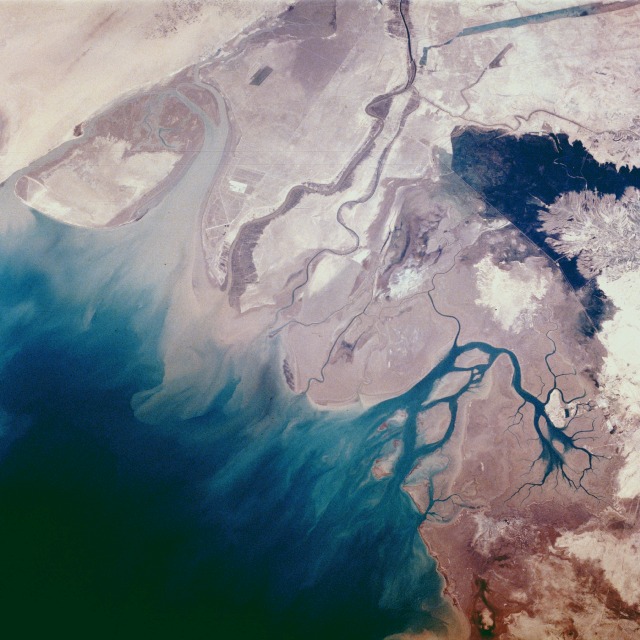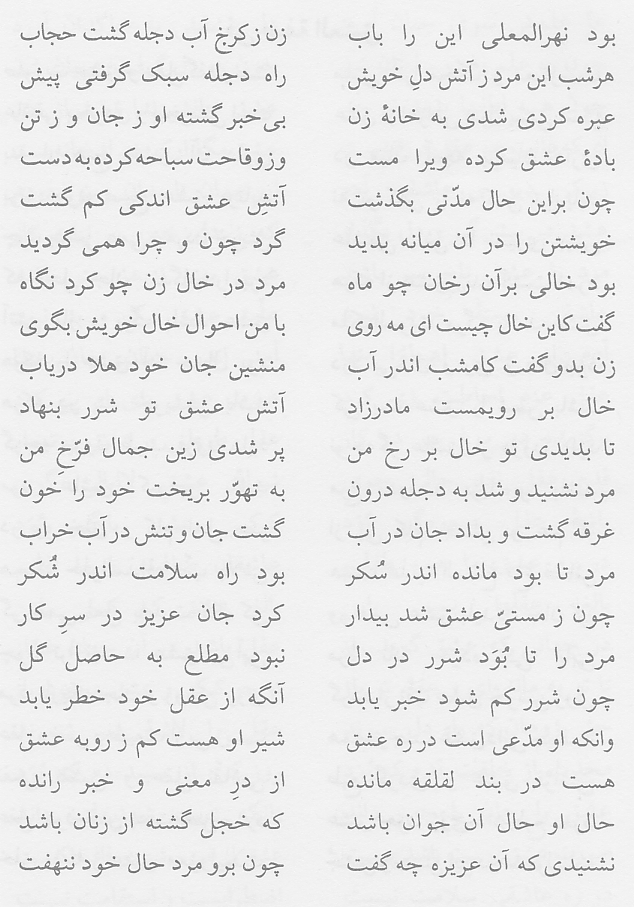
The Dawn of Love
I have heard a tale about a
man in Baghdad, who sacrificed
his heart. Brave and true on the path of love when suddenly fell in
love with a
maiden.
For him the giant river was a
gate, for her the waters of
Tigris a veil [1]. Each night consumed by the flames
in his heart, wafted above
the waters of Tigris light. Destined to her house lost all
consciousness of
health and heart. Drunken by the intoxicant of love, shamelessly swam
across
the river by his bare arms.
And this went on (night after
night) for a sometime, (but
soon) the fire within him diminished somewhat. Suddenly saw his Self in
the
midst, circling the “What?” and “Why?” around. (All this time
unnoticed) There
was a mole on her face, but now he saw the mole clearly.
Therefore he asked, “Where did
this mole come from my
beautiful one?”
She replied, “Tonight swim not
upon the waters, do not throw
your life away into the river?”
“(As for I) The mole on my
face a birthmark, (But for you)
burnt mark by the sparks of your love”
“Once you became brimmed with
the beauty of my face,
suddenly you saw this mark (as an imperfection)”
The man ignored her warning
and dived into the Tigris again,
drowned, lost the life, his heart and body decomposed in the waters.
For as long as a man dizzying
with drunkenness, safe from
the quills of porcupine. [2] But once awakened sober from the
drunkenness of
love, putting his life on the line.
For as long as flames (of
love) within the heart ablaze, man
unconscious of the outcome of life’s affairs.
But once the fire reduced
(even a bit), suddenly mind taking
over aware of the approaching perils.
On the path of love when one
on a quest, his lion far
inferior to the love’s (crafty) fox. Enslaved by the rattling chains of
vanity,
rejected from the gates of meanings and tidings. His demeanor that of a
young
lad, shyly infatuated by women.
Didn’t you hear what the
beautiful one advised, since for
her “his Self” not concealed.
This story is uncovering an
important Sufi secret about the
Self. In order to understand the poem properly, the authors of the
Farsi
transcript included an excerpt, another rendition of this story by
Ahmad
Al-Ghazali in “Sawaneh”:
“Although the beloved is the
subject matter of loving for
the lover, it exists as beloved as long as the lover’s ‘Self’ is
absent,
beloved’s manifestation does not exist by its own (needs a self-less
lover… and
continues with the story above…). And this is a significant and
splendid
secret, its uncovering points to:
Not conscious of love nor
loving
Not my Self not even the
beloved“ [3]
Lets go over the story. The
man was romancing the girl and
each night swam the fatally frigid waters of Tigris that normally kills
and
drowns any man. But the fire of love within him kept him warm and
strong to swim
the river to see his beloved. All this time the girl had an
imperfection a
mole/scar on her face. But the guy was so in love that became EYELESS
did not
see the mole. Now as time passed on his love just a little bit
diminished.
Notice the emphasis on the “little bit” by Sanaa-ee. Now this little
bit of
decrease in love has several significant side effects:
- Once the love decreases even a bit,
suddenly the lover’s mind takes over and questions fly around e.g. “why
her?” “You can do better”…
- The Self enter the arena of loving and
messes things up by selfishness and giving things order and look for
the lover’s best interest (so called)
- In doing so the Self eventually
extinguishes the flames of love, which then puts the life of the lover
in jeopardy for some danger to gobble up and destroy.
- The beloved becomes inferior and love
can no longer be justified. The slightest little imperfection (the
mole) becomes the focus of criticism instead of loving itself.
On the contrary, if love is in
full ablaze it means:
- Self is forsaken by the lover or the
flames of love completely consumed the lover and nothing of him is left
except loving
- Whether there are dangers or not,
lover is most courageous and brave prepared to face all manners of
afflictions and tribulations
- The beloved is most perfectly
flawless, there is no time and reason for lover’s eyes to see anything
other than that
- Lover is free of all confusions and
questions like why or what! Thus no matter what hardship faced there is
no stress and emotional disorder
How does this relate to the
Beloved the Creator of heavens
and earth:
- There is no way you love the Beloved
(your God) unless you do away with your Self. Selflessness is the
requirement for this love. If you sense the Self within you, your love
will spoil and shall bring your pain and destruction
- No matter what Beloved decrees, though
others may question or criticize, for you it is perfection beyond any
“Why?”. The only question you ask as a lover of Allah is: “What/how
should I do/act now that Beloved decreed this?” In other words you
become EYELESS or you see no fault or imperfection associated with the
Creator.
- When you are Selflessly in love with
the Beloved, your courage and powers are intensified. Like the man who
swam the frigid waters of Tigris every night, you will be able to
achieve feats unimagined by ordinary self-centered men. Lover can bear
afflictions and tortures of life that ordinary men would succumb to. He
stands as a power being constructed from love in the shadow of beauty
of Beloved.
The Sufis have used stories of
love to describe by a
parallel parable the love for Beloved. In doing so, they have focused
on
certain kinds of love:
- Intimacy (Ashq): Love for women
- Greed (Oz): Love for wealth and power
- Hypocrisy (Ria): Love for people’s
eyes to see you doing righteous actions though you heart is otherwise
These 3 forms of loving are
the most intense within.
Since love is love, Sufi poets have used the tales about these forms of
love as
a guide for loving the Beloved.
In particular intimate love
for a woman is focal for the
Sufis. Though mostly celibate and very pious, they understood some
attributes
of women lost in today’s hollywoodification of women:
- First time Beloved sends you to this
earth, even in case of father-less Prophet Jesus, it is via the
intermixing of the flesh and love of the woman. It is forbidden for any
man to enter upon the surface of this earth without crossing the BRIDGE
i.e. the woman.
- For some men, whom Allah has blessed,
the woman again is a BRIDGE but this time to cross and go back to the
Creator! This is when the love/heartache of the woman frees the lover
from the Self, he loves her not maternal nor sexual but a form of love
only set aside for the chosen few to be returned to their true Owner.
This form of love is lost today due to the pop culture and
industrialization of women. Remember the day a heartache came to you
when something she did or happened to her... your tears rolled down,
you fell on your knees begging Allah for her, you gave much money to
charity and made vows that if Allah removes this pain of her from you,
you shall spent such and such or do such and such to please The
Majesty. Well that was when she became the bridge, you could have just
walked over to the Beloved.
[1] Tigris is a river in Iraq with many
famous biblical and
contemporary events happening around it. It is used in the story due to
its
size and difficulty of crossing it for a single man. I assume Sanaa-ee
means
that the river was a gate for him to go through to see his beloved, for
her
this gate was blocked or curtained (like the door covers in mid east
and India) by
means of the river.
[2] Porcupine in Farsi is an animal
shooting arrows from its
back at people and here it refers the dangers of life, self, destiny,
and people…
[3] When a lover falls in love with
the Beloved, there is no
longer his self, void are the love or acts of loving and devotion nor
even the
concept of Beloved (Beloved is a word a Name), because it is all
dissolved and
reunited into One-ness (Tawheed) nothing left except that which we call
the
Beloved(though even the name is gone). And this is the secret that
dawns the sunrise of love…
Background: Tigris River viewed
from satellite. I
think the long windy curve diagonally/upwards is the river.
©
2003-2002, Dara Shayda






